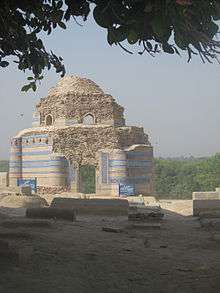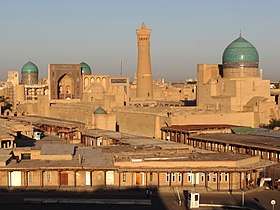Jalaluddin Surkh-Posh Bukhari
| Jalaluddin Surkh-Posh Bukhari | |
|---|---|
 Jalaluddin Bukhari's tomb | |
| Mir Surkh, Mir Buzurg, Makhdum-ul-Azam, Surkh-Posh, Jalal Ganj | |
| Born |
1198[1] Bukhara, now Bukhara Region, Uzbekistan |
| Died |
20 May 1292 (aged 93–94)[1] Uch, near Bahawalpur, Punjab Province, Pakistan |
| Venerated in | Islam (Suhrawardi Sufi order) |
| Influences | Baha-ud-din Zakariya |
| Influenced | South Asian Sufis |
Part of a series on Islam Sufism |
|---|
|
|
List of sufis |
|
|
Jalaluddin Surkh-Posh Bukhari (Urdu: سید جلال الدین سرخ پوش بخاری, c. 595-690 AH, 1198 – 1292 CE) was a Sufi saint and missionary. He was a follower of Baha-ud-din Zakariya of the Suhrawardiyya order.
Names
Bukhari, a family name, is derived from his birthplace, Bukhara, in modern Uzbekistan.[2] Bukhari is a Sayyid from Naqvi denomination, a descendant of the Islamic prophet Muhammad through his grandsons, Hasan ibn Ali or Husayn ibn Ali in the male line. Bukhari was born Jalaluddin Haider. However, he has a number of names and titles. He is known as Jalal Ganj; Mir Surkh (Red Leader); Sharrif ullah (Noble of Allah); Mir Buzurg (Big Leader); Makhdum-ul-Azam; Jalal Akbar; Azim ullah; Sher Shah (Lion King); Jalal Azam and Surkh-Posh Bukhari.[3] With formal honorifics, Bukhari is known as Sayyid Jalaluddin; Mir Surkh Bukhari; Shah Mir Surkh-Posh of Bukhara; Pir Jalaluddin Qutub-al-Aqtab; Sayyid Jalal and Sher Shah Sayyid Jalal.
Bukhari was known as Surkh-posh ("clad in red") because he often wore a red mantle.[1]
Career
Bukhari's life was spent travelling. As an Islamic missionary, he converted tribes such as the Soomro, Samma, Chadhar, Sial, Daher and the Warar. Bukhari was one of the Chaar Yaar (not to be confused with the Rashidun). The Chaar Yaar were the group of pioneers of the Suhrawardiyya Sufi and Chisti movements of the 13th century. Bukhari founded the "Jalali" section of the Suhrawardiyya order of Sufi. He converted the Samma, the Sial, the Chadhar, the Daher and the Warar tribes of the Southern Punjab and Sindh.
Some of his followers (mureed) spread to Gujarat. The mureed included Bukhari's grandson, Jahaniyan Jahangasht (d. 1384 CE) who visited Mecca 36 times. Other mureeds included Abu Muhammad Abdullah (Burhanuddin Qutb-e-Alam) (d. 1453 CE) and Shah e Alam (d. 1475 CE). In 1134 CE, the Sial followers of Bukhari settled in the community that is now Jhang. In the late 17th century, the settlement was washed away. Bukhari's descendent, Mehboob Alam Naqvi-ul Bukhari Al-Maroof Shah Jewna, encouraged the followers to resettle the area. Many of Bukhari's disciples are buried in Banbhore and Makli Hill near Thatta.
Legendary meetings
Sultan of Delhi
In 642 AH, when Jalaluddin Surkh-Posh Bukhari had begun his missionary work in Uch Shareef, he was visited by Nasiruddin Mahmud of the Delhi Sultanate.
Shah Daulah Shahid
Shah Daulah Shahid, is a Muslim saint who is buried in Bengal. In Bukhara, Bukhari presented Saint Daulah with a pair of gray pigeons. From Bukhara, Saint Daulah travelled to Bengal where he battled and was killed by the Hindu king of Shahzadpur.[4]
Lalla
One of Bukhari's female disciples was Lalleshwari (Lal Ded) (d. 1400 CE, Bijbehara). She interacted with Jahaniyan Jahangasht, a descendant of Bukhari and was impressed by him. She travelled in Kashmir with him. Lalla was a teacher of Nuruddin Nurani who is considered by the Kashmiris, both Hindus as well as Muslims, as the patron saint of Kashmir.[5]
Chengiz Khan
Per legend, on his way to India, he also met Chengiz Khan, the Mongol conqueror, and tried to convert him to Islam but failed.[1]
His two male issues from his second wife, Fatima, the daughter of Sayyid Qasim Hussein Bukhari, Sayyid Ali and Sayyid Jaffar, are buried in tombs at Bukhara. He brought his son Sayyid Baha-ul-Halim with him to Sindh and then he settled in Uchch in 1244.
Death
In 1244 CE (about 640AH), Bukhari moved to Uch, Sindh with his son, Baha-ul-Halim, where he founded a religious school. He died in about 690 AH (1292 CE) and was buried in a small town near Uch. After his tomb was damaged by flood waters of the Ghaggar-Hakra River, Bukhari's remains were buried in Qattal town. In 1027 AH, Sajjada Nashin Makhdoom Hamid, son of Muhammad Nassir-u-Din, moved Bukhari's remains to their present location in Uch and erected a building over them. In 1670 CE, the tomb was rebuilt by the Nawab of Bahawalpur, Bahawal Khan II.
The tomb is a short way from the cemetery of Uch. It stands on a promontory overlooking the plains and the desert beyond. To one side of the tomb is a mosque decorated with blue tile work. In front of the tomb is a pool. A carved wooden door leads into the room containing Bukhari's coffin. UNESCO describes the site:
The brick-built tomb measures 18 meters by 24 meters and its carved wooden pillars support a flat roof and it is decorated with glazed tiles in floral and geometric designs. The ceiling is painted with floral designs in lacquer and its floor covered with the graves of the saint and his relatives an interior partition provides 'purdah' for those of his womenfolk. Its mosque consists of a hall, measuring 20 meters by 11 meters, with 18 wooden pillars supporting a flat roof. It was built of cut and dressed bricks and further decorated, internally and externally, with enamelled tiles in floral and geometric designs.[6]
Mela Uch Sharif
According to World Monuments Fund, "The ancient city of Uch was one of several metropolises founded by Alexander the Great on his crusade through Central Asia in the late 4th century BC."[7]
The Mela Uch Sharif is a week-long mela (folk festival) held in March – April in Uch. People from the southern Punjab come to honour Bukhari's role in spreading Islam. Participants visit Bukhari's tomb, and offer Friday prayers at the local mosque which was built by the Abbasids. The mela commemorates the congregation of Sufi saints connected with Bukhari. It aligns with the Hindu calendar month of Chaitra.
Family

Bukhari was born on Friday, the fifth day of the twelfth month (Dhu al-Hijjah) of the year 595 AH in Bukhara, in present-day Uzbekistan. Bukhari was the son of Syed Ali Al-Moeed and the grandson of Syed Ja’far Muhammed Hussain.[3] Bukhari's early education was provided by his father. He was later influenced by Syed Shahjamal Mujarad of Kolhapur State in modern-day India.
Fatima (first wife)
Bukhari's first wife was Syeda Fatima, daughter of Syed Qasim. Bukhari and Fatima had two children, Ali and Ja’far. In 635 AH, after Fatima's death, Bukhari moved with his two sons from Bukhara to Bhakkar, Punjab.[8] Both their sons Ali and Ja’far are buried in Bukhara.
Zohra (second wife)
In Bhakkar, Bukhari married Bibi Tahirah (Zohra), daughter of Syed Badruddin Bhakkari, the son of Sayyid Muhammad Makki. Zohra and Bukhari had two sons: Sadruddin Mohammed Ghaus (who moved to the Punjab) and Bahauddin Mohamed Masoom. Their descendants now live in and around Thatta, Uch (Deogarh) and Lahore. A daughter of Sadruddin Mohammed Ghaus married Jahaniyan Jahangasht.[3]
Bibi Fatima Habiba Saeeda (third wife)
After Zohra's death, Bukhari married the second daughter of Badruddin Bhakkari, Bibi Fatima Habiba Saeeda. They had a son, Ahmed Kabir, who was the father of Jahaniyan Jahangasht and Makhdoom Sadruddin.[3] It is mentioned within books of history that Sayyid Sadruddin's two brothers Sayyid Maah and Sayyid Shams objected to him marrying his two daughters to Bukhari and exiled Bukhari from Bhakkar.[9]
Ancestors and descendants
Bukhari's biography and family history are cited extensively in such works as the Marat-e-Jalali, the Mazher-i-Jalali, the Akber-ul-Akhyar, the Rauzat-ul-Ahbab, Maraij-ul-Walayat, Manaqabi Qutbi, the Siyar-ul-Aqtar, the Siyar-ul-Arifeen and the Manaqib-ul-Asifya. These manuscripts are held by Bukhari Sayyids, however the work Marat-e-Jalali was first published in 1918 in book form from Allahabad, India and its second edition with updates and more research material was printed as a book in 1999 from Karachi, Pakistan. His descendants are called Naqvi al-Bukhari. The part of Uch where the family settled is called "Uch Bukharian".
The lineage contains saints and religious leaders. Some moved to Turkestan and were married to the Tatar Mongols. Others moved to Bursa in Turkey and others moved to Bilot Sharif, in the district of Attock (Attock Khurd and the village of Kamra Kalaan) and in the district of Sialkot (in Tehsil Shakargarh, the villages of Kotli Shah Saleem Kala Chechi (Kara Chechen), of Nurkot, etc.) as well as to Wadpagga Sharif, near Peshawar, and in the Tribal Areas of Kurram, Orakzai and Kohat. There are a number of tombs of Bukhari descendants across the Punjab, Sindh, Indian Gujrat, Khyber Pakhtunkhwa and Uttar Pradesh in India. They include: Jahaniyan Jahangasht (d. 1308 CE), Baba Shah Jamal and Meeran Muhammad Shah aka Mauj Darya Bukhari in Lahore, Hazrat Baba Shah Saleem and Shah Nazar in Sialkot District and Rajan Qittal, Bibi Jawindi (c. 1492 CE), Bukhari's great granddaughter and Mir Mohammad Masoom, the forefather of the Bokhari Naqvi family of Dreg, Dera Ghazi Khan and Channan Pir and Wadpagga Sharif in Peshawar. Some moved to Firozpur, India then migrated into Pakistan mainly settling in Dipalpur tehsil.Great Grand son of Hz. Jahaniya Jahangasht Qazi Husamuddin Hasan Bukhari in Allahabad (Old Kara Manikpur) in Uttar Pradesh India and his descendants are presently found in Chail known as Naqvi Bukhari Syeds.
The tomb of Bibi Jawindi and the tomb and mosque of Jalaluddin Bukhari have been on the "tentative" list of UNESCO World Heritage Sites since 2004.[6] World Monuments Fund also promotes its conservation.[7]
Family lineage
According to Mara'at Jalali[3] and Malfuzul Makhdoom, Bukhari's lineage is:
- Jalaluddin Surkh-Posh Bukhari
- Ali Al-Moayad
- Ja’far
- Muhammad Abu al Fateh
- Mahmood
- Ahmed
- Abdullah
- Ali Al Ashghar
- Ja’far (d. 271 AH Samarra)
- Ali al-Hadi
- Muhammad al-Jawad
- Ali al-Ridha
- Musa al-Kadhim
- Ja'far al-Sadiq
- Muhammad al-Baqir
- Ali ibn Husayn Zayn al-Abidin
- Husayn ibn Ali
- Ali ibn Abi-Talib
See also
References
- 1 2 3 4 Anna Suvorova; Professor of Indo-Islamic Culture and Head of Department of Asian Literatures Anna Suvorova (22 July 2004). Muslim Saints of South Asia: The Eleventh to Fifteenth Centuries. Routledge. pp. 149–. ISBN 978-1-134-37006-1.
- ↑ Yasin M. and Asin M. (Ed.) "Reading in Indian History." Atlantic 1988. p41. Accessed in English at Google Books on 23 June 2017
- 1 2 3 4 5 Hassami S. K. A. B. Marat-e-Jalali (Red Clothed man from Bukhara) First Edition 1918, Allahabad, Second Edition 1999, Karachi.
- ↑ Wali M. A. (1904) "On the Antiquity and Traditions of Shahzadpur" Journal of the Asiatic Society of Bengal. Calcutta. January to December 1904. p2
- ↑ Sikand y. "The Muslim Rishis of Kashmir: crusaders for love and justice.", Accessed 23 June 2017
- 1 2 "Tomb of Bibi Jawindi, Baha'al-Halim and Ustead and the Tomb and Mosque of Jalaluddin Bukhari." UNESCO Global strategy, tentative lists, submitted 30 January 2004, Accessed 23 June 2017
- 1 2 "Uch monument complex." World Monuments Fund, New York, NY. Accessed 23 June 2017
- ↑ Qadr M. A. "Mukhdoom Jahaniyan Jahangasht"
- ↑ Al-Haqq, Sayyid Muin, ed. (2010). Manba Al-Ansab Urdu Translation. Madrassa Faydan Mustafa. p. 319.
External links
- "The Muslim Rishis of Kashmir: Crusaders for Love and Justice", by Yoginder Sikand